Echoes of the past are everywhere: This fanciful Colrain home was created in the shell of a former manufacturing business
| Published: 08-19-2024 4:29 PM |
Years ago, while visiting the Colrain home of Jon Lagrèze and Judith Roberts, two elderly sisters were astonished and amused by an apparatus installed above the stove, from which hung pots and pans. Lagrèze fashioned it from parts of an old conveyor belt he found after he purchased property that had housed the Cary Cider Mill, an apple cider vinegar manufacturing business. The sisters’ father had been the last manager of the business, which closed in 1950.
“One of the sisters pointed to a scar on her upper lip and said that, as young girls, they used to sneak into the factory after hours and ride down the conveyor belt on pieces of cardboard,” recalled Lagrèze. The vignette about an illicit ride ending in a bloody mishap is just one of hundreds about a remarkable place that’s chock-full of history, and where Lagrèze and Roberts have lived for decades.
Lagrèze seems capable of living in several centuries simultaneously, and does so with ingenuity and aplomb. According to Roberts, Lagrèze “can make or fix anything, and possesses the skills of an early 19th-century farm wife, growing a lot of food and preserving it.” Lagrèze and Roberts live in the Foundry Village section of Colrain, the former location of various kinds of manufacturing and industry. Lagrèze, 75, has lived there since the late 1970s; Roberts, 73, joined him in the early 1990s. Together, they’ve created a haven of creativity, fun, and efficiency on about an acre. Although they live where mills operated, their home is far from a run-of-the-mill.
Their grandkids delight in stepping through a door on the third floor and sliding down what looks like a firefighter pole. (It’s made from a dairy milking pipe.) After landing, they have the option of riding back up on a thick knotted rope, which rises when an able volunteer positioned above hand-operates a gigantic wheel. The place seems like a funhouse, museum, and retreat rolled into one, while also being a cozy domicile with home office spaces.
The abundant garden is among Lagrèze’s many noteworthy accomplishments; it’s located on adjacent land belonging to generous, supportive neighbors. In my next column, we’ll delve into the wonderful world of Lagrèze’s green thumb, but for now, let’s look around the home he manifested from former manufacturing spaces, and which Roberts helped transform into one of the most remarkable homes in Franklin County.
As I sat in their living room, taking in beautiful details, Roberts served shiso tea, a deep purple concoction made from a plant of Asian origin which Lagrèze began growing after Roberts discovered its delights during a trip to the U.S. west coast. (Culinary adventurers, beware: cultivated shiso varieties are lovely to eat and drink, but wild, weedy versions can be toxic.) A glance out the window reveals a lively bird population congregating around a sizable feeder that no bear has a chance of pilfering, given its height off the ground.
When viewed from the outside, the cheery bird feeder stands out against the rustic grey of the building, which is sided with its original embossed metal. “When I first saw it,” said Lagrèze, “the space where we now live was filled with cyprus vats.” The vats containing rattan were key elements in the apple cider vinegar factory; the rattan held what’s referred to as “the mother” — blobs or stringy by-products of fermentation. Today, the only mother in residence is Roberts, who calls her partner’s vision “amazing and unique. He did all this,” she said, indicating the gorgeous, multi-leveled spaces that make up their home.
Living quarters are on the second and third floors; the first is allotted for storage. The term “storage” includes not only food that’s drying following harvest, athletic equipment, and essential tools, but also hundreds of years worth of artifacts from the location’s previous incarnations, which included a butcher’s concern, a blacksmith, and an apiary supply business. Echoes of the past are everywhere, both visually and in Lagrèze’s captivating vignettes, including one about neighborhood children of yesteryear stopping on their way home from school at a roadside tap and helping themselves to fresh apple cider, back when the place was a cider business. (Check out the Colrain Historical Society’s website: colrainhistoricalsociety.org, where you’ll find riveting tidbits about a community that preserves cherished elements.)
Article continues after...
Yesterday's Most Read Articles
The building Lagrèze and Roberts live in was built in the 1860s to store beehives, and was the site of the first manufacturer of the famous Langstroth hives. Today, several stacked hives are the perfect display spot for vases of spectacular gladioli. Another blast from the past can be seen on the staircase to the third floor, which reveals that the mega pot-hanger wasn’t the only ingenious thing Lagrèze did with conveyor belt parts: the stair balusters are also made from conveyor track rollers.
When moving from one room to another, visitors often pause when faced with the question of how to open doors, since Lagrèze did not install regular door knobs. Truth be told, very little about the place would pass for “regular.” Lagrèze fashioned door openers inspired by examples he found in books written by Eric Sloane, an American landscape painter, illustrator, and author of books on cultural history and folklore.
Friends and family come and go with appreciation and delight, but one could say that Lagrèze and Roberts live, just the two of them, in their special spot. Yet one could also say that they cohabitate with a treasured companion who speaks, sings, and gurgles throughout every day and night. Foundry Brook runs right next to their living quarters, and Roberts said, “For me, this water is a live force. It washes away worries and strife, and is a very strong presence in our lives.”
Lagrèze rehabbed what was the apple cider vinegar testing lab into a darling veranda where Roberts practices yoga and the couple entertains visitors, with the brook just feet away. Lagrèze installed a steel tank through which runs fresh water so that Roberts can have her desired cold dunks even after dark, when she might not want to climb down the ladder to her tiny beach. (Roberts immerses herself in fresh, cold water 12 months of the year, along with other locals inclined to pursue this astounding practice.)
That waterway has been prized by locals for centuries. Around 1740, a grist mill operated across the road from where Lagrèze and Roberts now live. Later, there were turning shops, where lathes were operated with the help of rushing water. In the early 19th century, a foundry came into existence, specializing in liners for wood stoves, giving the neighborhood its current name. At one time, there was a shoemaker’s shop up the road. The location is pregnant with history: one can almost hear the ringing of the blacksmith’s hammer, or smell the apple pulp, leftovers from the apple cider vinegar business that were sometimes shipped to Natick to be used for pectin in Mother’s Pies. “The pulp was also tried as cow feed,” said Lagrèze.
As a boy, Lagrèze dreamed of farming. His favorite spots at home include the garden (three seasons of the year) and, during the winter, “The woodshop is my happy place.” He installed his shop in what had been the boiler house, one of the earliest buildings on the property. After coming to the area in 1976 and working in various natural foods businesses — including New England Country Dairy and Lightlife Foods — as well as doing carpentry, Lagrèze settled happily into the place he bought over a period of 10 years, beginning in 1979, thanks to a deal he made with the previous owner. “I was drawn here by my fascination with recycling things in a totally unique situation,” he said.
“I love that the weave of history is all around us,” added Lagrèze. “We’re temporary dwellers, but this place is much, much more.” He spoke of Indigenous people who inhabited the area before European settlers. “Jude and I? We’re just passing through this beautiful place where we’re fortunate to find respite.”
Eveline MacDougall is the author of “Fiery Hope,” and a musician, artist and mom. She loves hearing from readers at eveline@amandlachorus.org.

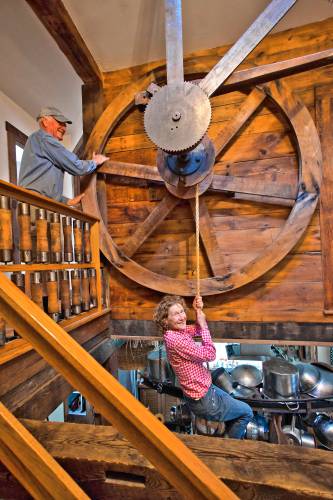
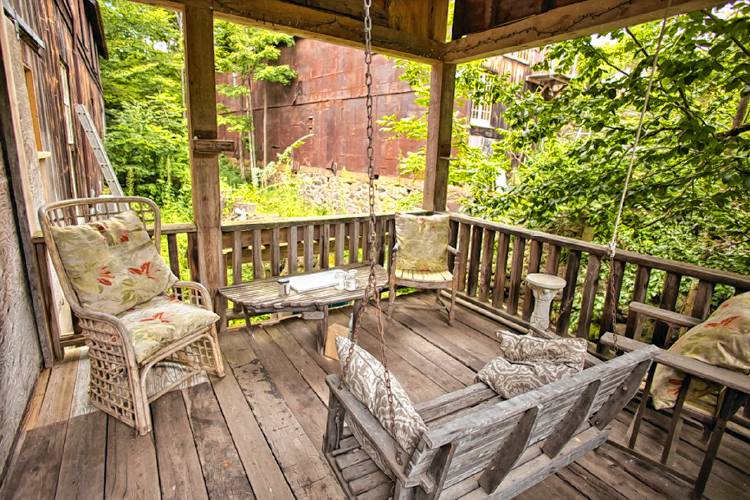
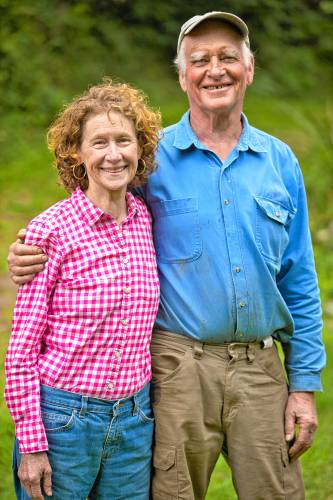
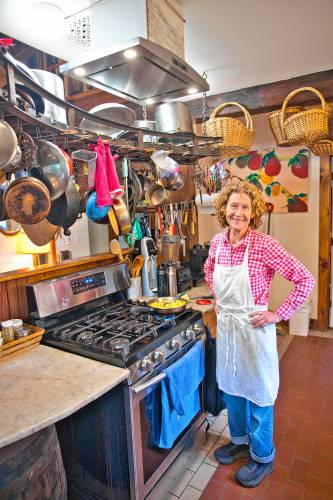





 Putting the students front and center: What can education can look like without high stakes testing?
Putting the students front and center: What can education can look like without high stakes testing? Sounds Local: He’ll play anything you want: Stephen Kellogg will perform an all-request show at Shea Theater, Dec. 19
Sounds Local: He’ll play anything you want: Stephen Kellogg will perform an all-request show at Shea Theater, Dec. 19 Speaking of Nature: Introducing the Birch Perch II: Making improvements to my bird observation venue
Speaking of Nature: Introducing the Birch Perch II: Making improvements to my bird observation venue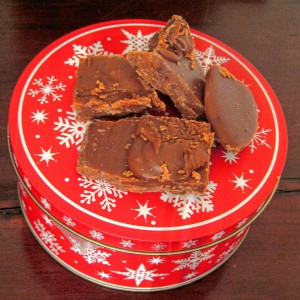 Conversations over candy-making: Sharing beloved holiday food traditions
Conversations over candy-making: Sharing beloved holiday food traditions
